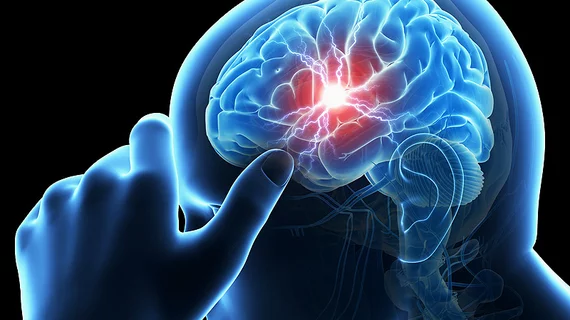Stroke patients see similar odds of readmission with thrombectomy, thrombolysis
About 1 in 8 patients who received endovascular thrombectomy (EVT) for acute ischemic stroke during a two-year period in the U.S. were readmitted to the hospital within 30 days, according to an analysis of the Nationwide Readmissions Database published in JACC: Cardiovascular Interventions.
The readmission rate of 12.4 percent was similar to that of patients treated with thrombolysis alone (12.6 percent), and thrombolytic therapy administered in conjunction with EVT wasn’t an independent predictor of readmission, reported lead author Islam Y. Elgendy, MD, and colleagues.
Elgendy et al. identified 10,795 cases in which EVT was performed in U.S. hospitals during 2013 and 2014. They then compared the risk of 30-day readmissions for those patients to a propensity-score matched group that underwent only thrombolysis, and also used a regression model to determine independent predictors of nonelective readmissions.
“Hospital readmissions represent significant physical and psychological burdens to stroke patients and their families,” wrote Elgendy, with the department of medicine at the University of Florida, and coauthors. “Given the economic impact on the health care system in general and the financial penalties imposed by Medicare on hospitals for readmission of stroke patients, it has become important to understand how the growing use of EVT might influence these rates.”
Among EVT patients, the most common reasons for 30-day readmission were infections (17.2 percent), cardiac causes (17.0 percent) and recurrent strokes or transient ischemic attacks (14.8 percent). The overall rate of recurrent stroke/TIA was higher in those treated with thrombolysis alone (23.4 percent), but the rate of hemorrhagic stroke was 2.5 percent in both groups.
Gastronomy tube placement was the strongest independent predictor of readmission among EVT patients, carrying a 2.08-fold risk of that outcome. Other independent predictors of readmission included Medicare or Medicaid insurance (compared to private insurance), coagulopathy, diabetes, acute MI, atrial fibrillation and heart failure during the index hospitalization.
“Several studies have demonstrated that infections such as pneumonia and urinary tract infections, as well as cardiac complications such as myocardial infarction and arrhythmias are common after acute ischemic stroke,” the researchers wrote. “The high incidence of readmission for cardiac causes and recurrent stroke suggests that secondary preventive measures for acute ischemic stroke, even in those undergoing EVT, is suboptimal. Arranging for early post-discharge follow-up, especially for those at increased risk such as older patients, may help mitigate this risk.”
In a related editorial, Salvador Cruz-Flores, MD, MPH, said the study is useful in establishing readmission rates associated with acute ischemic stroke care but leaves several unanswered questions.
“Given the limitations administrative datasets inherently have, we cannot clearly isolate the effects that acute interventions, secondary prevention, or transition of care processes have on readmission rate,” wrote Cruz-Flores, with the department of neurology at Texas Tech University Health Sciences Center El Paso.
Cruz-Flores said only two to four patients in randomized trials needed to be treated with EVT for one additional patient to survive with normal function or minimal disability. But he said it’s unclear whether a similar benefit is seen in routine practice, and whether potential differences would be related to operator performance, patient selection or technique standardization.
More work is also needed to determine the effectiveness of secondary prevention measures to prevent recurrent stroke, along with ways to improve adherence to those treatments, Cruz-Flores wrote.

